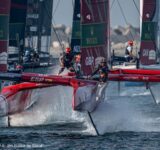- SailGP walked the line in Cadiz . . . and just about got away with it
SailGP Cadiz day 1 showed why sailing struggles as a spectator sport . . . day 2 showed sailing as a genuine rival to Formula 1 on a rain-soaked track.
Saturday bordered on farce as the tooled-up F50s replete with most of the worlds top racing helms and crew crept around ever shorter courses.
In two of the three races most of the fleet failed to finish in the 15-minute time limit despite the shortened courses, a not unusual situation in yacht racing in light conditions.
It would have been sensible to postpone at least the third race to the Sunday, which had a better weather forecast, but difficult to explain to the media companies trying to fill their broadcast slots.
It also meant that the paying spectators in Cadiz saw less than on hour of actual racing and most of that comprised of a scattered collection of boats struggling to make any progress.

Sunday was a completely different situation.
With the breeze now between force 4 and 5 (12 to 20 knots) and kicking up a considerable sea state suddenly there was the scent of danger in the air.
The Spain GP team set the bar high, managing to capsize and wreck their mainsail even before the racing started, they were towed back to shore, their event over.
For the seven remaining teams it was game-on, with every tack and gybe an opportunity to lose control and the mark bear aways evoking memories of the spectacular crash by American Magic in the last America’s Cup.
Finally, SailGP delivered the non-stop action it had promised in those over-hyped promos.
The final podium race with just three teams taking off from the start at speed, with Ainslie’s British team hitting 82km/hr (44 knots) just before they pitch-poled, with the Australian and American teams swerving round them to avoid a catastrophic pile-up . . . was media gold.

But a solution must be found to presenting competitive racing on a regular schedule, in widely varying weather conditions.
Other sporting events are affected by the weather, but sailing depends on the weather to perform, it cannot roll out a mechanical roof or a plastic pitch, and therein lies its Achilles heel.
Looking yet again to Formua 1, SailGP may need to concentrate on the full fleet format to maintain interest and even some sort of virtual pace boat to force a re-group start.
A restart after the British crash so early in the race, even if they had been unable to compete within an agreed time, would have at least produced a fairer race spectacle. Which after all is what SailGP is suposed to deliver, one boat lapping on its own is not a race.
For SailGP management this is obviously still a work in progress.
Larry Ellison and Russell Coutts have shown what can be done with unlimited funds and effort, but can they convince a sceptical world that competitive sailing is really the next big thing?
Related post:







